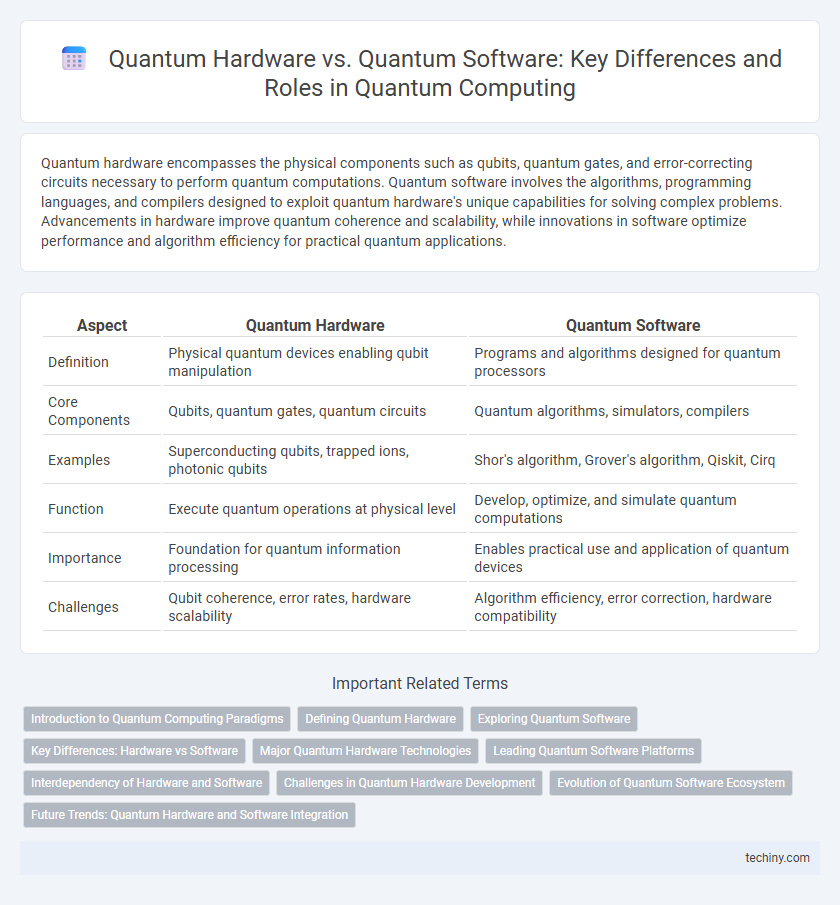Quantum hardware encompasses the physical components such as qubits, quantum gates, and error-correcting circuits necessary to perform quantum computations. Quantum software involves the algorithms, programming languages, and compilers designed to exploit quantum hardware's unique capabilities for solving complex problems. Advancements in hardware improve quantum coherence and scalability, while innovations in software optimize performance and algorithm efficiency for practical quantum applications.
Table of Comparison
| Aspect | Quantum Hardware | Quantum Software |
|---|---|---|
| Definition | Physical quantum devices enabling qubit manipulation | Programs and algorithms designed for quantum processors |
| Core Components | Qubits, quantum gates, quantum circuits | Quantum algorithms, simulators, compilers |
| Examples | Superconducting qubits, trapped ions, photonic qubits | Shor's algorithm, Grover's algorithm, Qiskit, Cirq |
| Function | Execute quantum operations at physical level | Develop, optimize, and simulate quantum computations |
| Importance | Foundation for quantum information processing | Enables practical use and application of quantum devices |
| Challenges | Qubit coherence, error rates, hardware scalability | Algorithm efficiency, error correction, hardware compatibility |
Introduction to Quantum Computing Paradigms
Quantum hardware encompasses the physical quantum processors, including qubits implemented through superconducting circuits, trapped ions, or topological systems, which form the foundation of quantum computation. Quantum software involves the algorithms, programming languages, and error-correction techniques designed to harness quantum mechanical properties such as superposition and entanglement for problem-solving. Understanding the interplay between diverse quantum computing paradigms, including gate-based, adiabatic, and measurement-based models, is essential for advancing both quantum hardware development and efficient quantum software design.
Defining Quantum Hardware
Quantum hardware comprises the physical components essential for realizing quantum computing, including qubits, quantum gates, and control systems that manipulate quantum states. These hardware elements enable phenomena like superposition and entanglement, which underpin quantum computation's exponential speedup over classical systems. Advances in error correction, coherence time, and qubit fidelity are critical metrics defining the performance and scalability of quantum hardware platforms.
Exploring Quantum Software
Quantum software drives the functionality of quantum hardware by developing algorithms that leverage quantum bits (qubits) for complex computations. Advances in quantum programming languages and error-correcting codes optimize the performance and reliability of quantum processors, enabling practical applications in cryptography and optimization. Exploring quantum software unlocks new potentials in simulating molecular structures and solving classically intractable problems.
Key Differences: Hardware vs Software
Quantum hardware consists of physical qubits implemented through superconducting circuits, trapped ions, or topological qubits, providing the foundational infrastructure for quantum state manipulation. Quantum software involves algorithms, error correction protocols, and quantum programming languages designed to optimize computations and control hardware operations. The core difference lies in hardware enabling quantum phenomena physically, while software translates complex quantum problems into executable instructions for effective hardware utilization.
Major Quantum Hardware Technologies
Superconducting qubits, trapped ions, and topological qubits represent the major quantum hardware technologies driving advances in quantum computing. Superconducting qubits utilize Josephson junctions to create scalable quantum circuits, offering fast gate operations and integration with existing semiconductor technologies. Trapped ions provide high-fidelity qubits through electromagnetic confinement of individual ions, while topological qubits promise robust error resistance by encoding information in non-local quantum states.
Leading Quantum Software Platforms
Leading quantum software platforms such as IBM Quantum, Microsoft Azure Quantum, and Google's Cirq provide robust development environments tailored for quantum algorithm design and simulation, bridging the gap between complex quantum hardware and accessible programming interfaces. These platforms support various quantum programming languages like Qiskit, Q#, and OpenQASM, enabling optimized circuit construction and error mitigation on real quantum processors. By abstracting hardware constraints and offering cloud-based access to quantum devices, leading software frameworks accelerate innovation in quantum computing applications across cryptography, optimization, and material science.
Interdependency of Hardware and Software
Quantum hardware and quantum software are deeply interdependent, as the performance of quantum algorithms relies heavily on the capabilities of qubits, quantum gates, and error correction mechanisms integrated into the hardware. Advances in quantum error correction codes and pulse-level control software directly enhance the stability and coherence times of hardware components, enabling more complex computations. Optimizing quantum compilers and programming languages tailored to specific quantum hardware architectures drives improvements in execution efficiency and scalability of quantum applications.
Challenges in Quantum Hardware Development
Quantum hardware development faces significant challenges due to qubit coherence times, error rates, and scalability constraints, limiting the performance and reliability of quantum processors. Physical qubits require extreme conditions, such as ultra-low temperatures and isolation from environmental noise, to maintain quantum states, complicating hardware design and operation. Advances in materials science and error correction techniques are critical to overcoming these barriers and achieving practical, large-scale quantum computing systems.
Evolution of Quantum Software Ecosystem
Quantum software ecosystems have rapidly evolved to bridge the gap between complex quantum hardware and practical applications, with frameworks like Qiskit, Cirq, and Forest enabling developers to create, simulate, and optimize quantum algorithms. Advances in quantum programming languages and compiler techniques have enhanced error mitigation, resource estimation, and hardware compatibility, accelerating the deployment of quantum solutions. Continuous improvements in software tools are critical in harnessing the full potential of quantum processors, driving innovation across cryptography, optimization, and machine learning domains.
Future Trends: Quantum Hardware and Software Integration
Future trends in quantum computing emphasize seamless integration between quantum hardware and software to enhance computational efficiency and scalability. Advances in qubit design, error correction techniques, and quantum algorithms are driving this convergence, enabling more robust and practical quantum systems. The co-development of hardware-software ecosystems will accelerate breakthroughs in quantum machine learning, cryptography, and optimization problems.
Quantum Hardware vs Quantum Software Infographic

 techiny.com
techiny.com